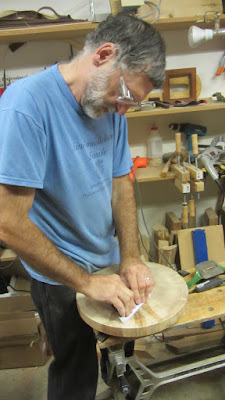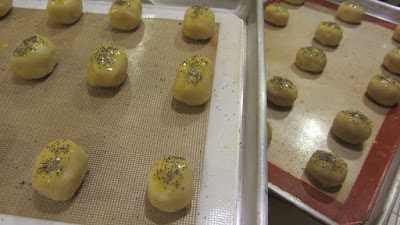Today’s coffee: Rwanda (still drinking Tokumitsu coffee, which I’ve been hoarding…)
Yesterday was a long day: I did a tea ceremony presentation for high school students at Missions Fest Seattle. There were a lot of preparations, but what resulted was a uniquely Pacific Northwest style of tea ceremony. (It wasn’t necessarily “correct,” but sometimes it’s fun to be creative.) Let me explain.
 |
| Here's my setup. Unconventional, but that's not a bad thing. |
Tea ceremony can be pretty expensive. There are lots of valuable (breakable) tools and accessories and clothing, so I try to get things used whenever possible. Here in Seattle, it’s hard to get tea ceremony equipment at all. But I have discovered some work-arounds for these problems, or, to put it in inappropriately casual terms, life hacks for tea ceremony.
There is a precedent for this way of thinking. Sen no Rikyu, the founder of tea ceremony as it is currently practiced, repurposed everyday objects for use in tea ceremony: peasants’ rice bowls became tea cups, tubes of bamboo became flower vases, and rustic iron cauldrons became kettles for tea water. I’m just putting Rikyu’s wisdom into practice… is what I say to justify myself.
I collected various tools in Japan and brought them to Seattle, but a hearth (furo) was too large and heavy. I figured I could find something comparable. Thankfully, the fruit stand at the bottom of the hill was selling their planter pots at half off for end of season clearance; I purchased a large (despicably heavy) brown clay planter.
This setup needed some work, though. First, I needed an electric burner to keep my tea kettle warm. I found one on Amazon for $13. Sweet!
Next, I needed a slab of wood to keep the planter from damaging the picnic mat I sit on when doing tea ceremony. The picnic mat itself was a life hack, since transporting tatami mats from Japan would have been nearly impossible. I asked my dad if he might be able to cut a cross section of a tree and clean it up a bit. In typical fashion, he took my simple request to a whole level beyond what I had expected. Dad chain-sawed a round off a log from a tree behind our house (part of the tree was rotten, so it had to be cut), then cleaned it up in his workshop.
 |
| The log. |
 |
| Dad working on the cross section of log to make it pretty. |
The gigantic coaster, as we started calling it, and the matching insert to adjust the height of the burner and tea kettle, turned out gorgeous.
 |
| My kettle (tetsubin), which I brought with me from Japan, hanging out in its new home (planter pot fitted with two slabs of maple tree). The tea tray in the foreground came from the same tree. And of course, my beloved picnic mat and tea basket. |
I also needed a tea tray. I could have easily brought one home, since they are light and small, but my dad can make guitars, so a tea tray ought to be child’s play, right? Dad used many of the same techniques he uses for guitars (bent sides around a book-matched piece of maple from the same tree as the previously mentioned coaster).
 |
| Dad bends the side of the tea tray with his bending iron |
Of course, I couldn’t imitate Rikyu properly without also scouring the house for interesting objects to use. I re-discovered a painted screen which had adorned my grandparents’ living room fall for decades, and set it up behind me to give the feel of being in a tea room. Keith carried sweets to our guests using a wooden tray my grandfather made. I also found a cute flower vase from our exchange student’s hometown in Wernigerode, Germany, which Mom filled with late autumn flowers from the garden.
We didn’t have enough chawan (tea bowls) for the number of guests we expected. Solution: Say hello to my first project in pottery class.
 |
| It's a bit lumpy, but it worked out fine. |
Then of course we needed wagashi (Japanese sweets). Since it’s rare to find proper wagashi outside of Japan, my Seattle-area teacher makes all her own wagashi for our classes (I look forward to them every time!!) The only thing to do was make them myself! It’s autumn, so it was perfect timing to make the
kuri manjū (chestnut buns) I learned to make from a friend at church. I also tried making kuri yōkan for the first time. (Mine didn’t look as pretty as hers.)
 |
| Here's what they looked like before they went in the oven. I forgot to take an after picture. Preoccupied with other stuff, I guess. |
Finally, I needed helpers. Keith was an obvious choice for the hantō role, carrying tea and sweets to each guest while I prepare the tea. He had to kneel and stand 2 or 3 times in front of each person (about 30 total guests), amounting to the equivalent of about 80 squats. His legs are pretty tired, he says. After a last minute crash course (the day before), Mom took on the backstage helper role, standing at the back of the room while making tea and washing tea bowls, since I couldn’t go fast enough by myself.
 |
| Last minute practicing in our living room |
Yesterday, I got up at what seemed like the crack of dawn to do final preparations, and off we went!
I thought there would be 10 high school girls for tea… but far more showed up than expected. After the first 14 or so, Keith started taking down reservations for a second session. Thankfully, I brought more than twice as many kuri manjū as I thought I needed.
 |
| This was session #2. |
I served tea as part of a presentation in which I told stories about our life and work in Japan, talked about the history of tea ceremony, and then invited everyone to enjoy some quiet, reflective time while I prepared and served the tea. No rest for Keith or Mom, though. They were working hard the whole time.
This morning I had tea ceremony class. I enjoyed being served by my teacher and fellow students after experiencing firsthand the extent of the preparations for an ochakai (tea gathering). Next time there should be fewer tools to make from scratch, though.